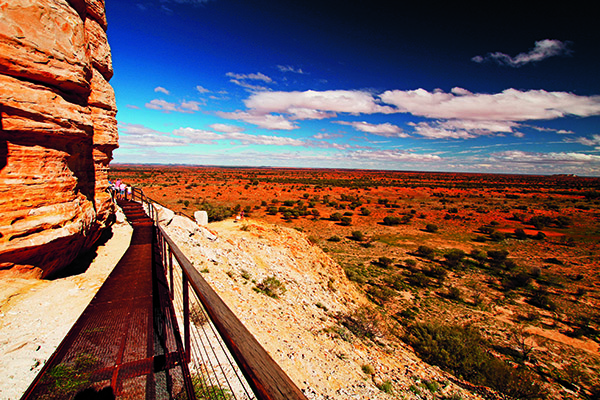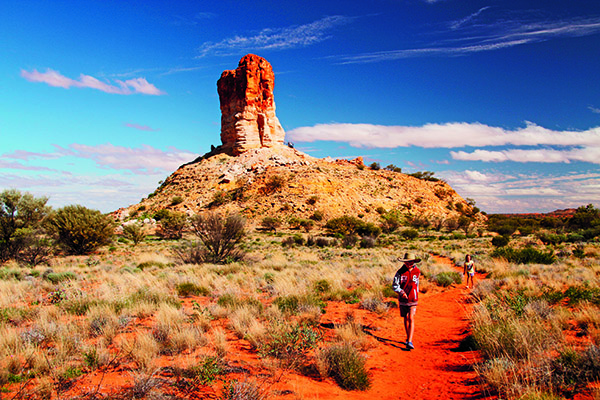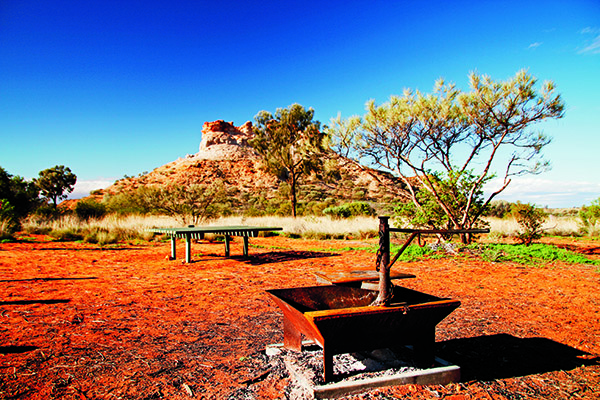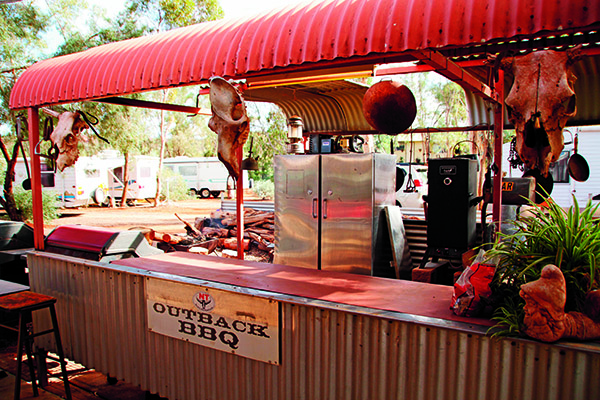A journey to iconic Chambers Pillar on the western fringes of the Simpson Desert is an epic adventure through remote areas that has you following in the footsteps of Scottish explorer John McDouall Stuart. This impressive 50m sandstone pillar itself towers above the surrounding desert plains and has served as an outback landmark for centuries.
It was the indomitable Stuart who first laid eyes on this remarkable sandstone formation on April 6, 1860, on his journey to cross the continent from south to north. He named the pillar after James Chambers, one of his South Australian sponsors.
It wasn’t until his third attempt in 1862 that he was successful in crossing Australia, making way for the overland telegraph line which, in turn, heralded the start of white settlement in Central Australia. Stuart endured extreme hardships on his expeditions and died four years after his perseverance made the heart of our vast continent accessible.






IN STUART’S STEPS
These days, we don’t face such extreme hardships to travel to this fascinating landmark, but it doesn’t mean you shouldn’t be prepared. Chambers Pillar Historical Reserve is considered a remote outback location, and has no access to water. Travellers must ensure their car and rig are in excellent condition before heading off the black tar and facing 151km of dirt road, including sandy sections.
Our own journey started at Stuarts Well Roadhouse, 90km south of Alice Springs, where friendly staff provided us with a detailed route description to Chambers Pillar. This roadhouse is worth a visit in its own right as it has a camel farm next door and provides free camping as well as powered sites, starting at $25 per night.
You can also learn about the amazing history of Jim’s Place pub, which is owned by tourism pioneer Jim Cotterill. Jim and his father Jack were the first people to recognise the potential of Kings Canyon as a major tourist destination and cut a 100km road to the base of the climb in the early 1960s. Their foresight signalled the start of tourism in the Red Centre.
TAPE ’EM UP
From Stuarts Well, the turnoff to the Hugh River Stock Route is 10km away. It pays to keep an eye out for the signpost because it’s only small. Once you’re on the dirt, it’s advisable to lower your tyre pressures to ensure a softer ride. We also tape up vents and door seals which are likely to let dust in – a 10 minute job that can save a lot of cleaning afterwards.
Here the outback adventure begins. Leaving behind the crowds on the Stuart Highway, you venture inland, passing through several pastoral properties. You’ll come across numerous gates to keep cattle in the right places, so always close the gate after passing through. The graded track is generally in good condition, but can become impassable after heavy rain.
After 33.8km the Old Ghan Railway will come into view, heralding the second stage of the trip. Completed in 1929, the railway was replaced by the new Ghan line in 1980 which is further west, making the old one obsolete.
Crossing the railway, you turn left in the direction of Maryvale Station. The winding track passes under the old railway bridge then heads further inland. The next 35.4km travels a graded track that’s easy to navigate and bring you to the intersection with Old Main South Road, the start of the third stage. This major road is more like a highway as it’s wide and has a hard base. Adjacent to the road you’ll notice a narrow dirt track which is used for the ridiculously popular Finke Desert Race, held in June each year.
Follow Old Main South Road for 31.2km until you reach Maryvale Station, the last bit of civilisation before heading further into the desert. This is the place to fuel up, buy basic groceries or enjoy morning tea.
The fourth – and longest – section is the final 42km from Maryvale to Chambers Pillar. This track is narrow and can be rough, depending on when it was graded. Keep your eyes open for brumbies, wild donkeys, camels and big red roos as they frequent in these remote parts.
SOMETHING SPECIAL
During the past eight years I’ve travelled to every corner of this magnificent continent and driven many of our famous 4WD tracks, but this was an entirely different experience. The sense of isolation was intense, adding to the adventure. Apart from a group of motorbike riders who were preparing for the Finke Desert Race, it appeared we were the only people heading out to the pillar.
The kids noticed a group of brumbies and wild donkeys far away on our left, but they were seemingly undisturbed by our presence. We rolled through a few muddy spots – remnants of the recent rains – but nothing serious. Just as we were starting to wonder how much further we had to go, the spectacular Charlotte Range came into view.
It is advisable to negotiate the fairly steep and rocky climb and its descent in low range, especially when towing. The views from the top are simply stunning and worth a short break. After descending the Charlotte Range, the final stretch involves crossing several sand dunes.
General driving information available on the internet makes it sound as if these dunes have deep, soft sand, but nothing could be further from the truth. The 4-5m dunes are easy to cross, but a lot of them do have blind corners. For this reason it is recommended to have a tall orange flag on the front of your vehicle. Monitoring UHF channel 10 may also be helpful to let other drivers know of your position and direction.
A PILLAR OF YOUR OWN
At long last the famous pillar came into view, looking small at first. As we drove into the reserve and made our way to the campground, the family’s excitement grew. Setting up just 400m from Chambers Pillar, we raced down the walking track and up the many steps to the viewing area on the massive rock. The wind was unbelievable, whipping us in the face and making it next-to-impossible to hold a conversation. Climbing this dramatic 50m sandstone formation in the middle of Central Australia, with the desert stretching out in every direction, I stood awestruck.
Standing on the narrow viewing platform, looking at the inscriptions that had been left behind by John Ross who led the Overland Telegraph Party in 1870 and by Alfred Giles who was with him, I wondered how these men had felt when they reached the pillar. Stuart however, never left his name on the rock, but recorded the visit in his diary.
To watch a sunset here is an unforgettable experience. As the last rays of sun touch the sandstone, the pillar appears to be ablaze in bright orange and deep red – a sight engraved in my memory. The next morning we watched Chambers Pillar come alive again as the sun hit the rock face, before making our way back to civilisation.
Some places you can read about, other you really have to experience for yourself – this is one of them.




